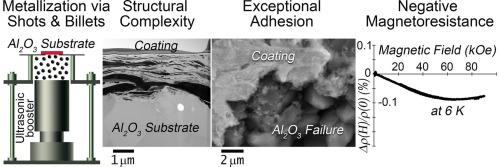Solid-state methods for ceramic metallization: Unlocking structural complexity, quantum effects, and multifunctionality
IF 22
1区 材料科学
Q1 MATERIALS SCIENCE, MULTIDISCIPLINARY
引用次数: 0
Abstract
The metallization of ceramics is essential for advanced technological applications but remains challenging due to poor metal-ceramic adhesion and structural incompatibility. A solid-state mechanical alloying approach using ultrasonically assisted shot impact processing, which can also utilize metallic cubic billets as a coating material source, is introduced. This approach is demonstrated on W-Al- and W-Ni-based coatings fabricated on alumina substrates. The method enables the formation of a structurally complex system, integrating amorphous regions, nanocrystalline grains, and localized non-equilibrium solid solutions into a uniform structure. The as-fabricated coatings impart electrical conductivity and magnetic properties to the initially insulating ceramic substrate, while their exceptional adhesion ensures mechanical integrity, allowing the coating to co-deform with the substrate without delamination prior to ceramic fracture. Additionally, quantum transport phenomena, including weak localization and negative magnetoresistance at 6 K, are observed, revealing a direct correlation between structural complexity and electronic behavior. The emergence of quantum phenomena in mechanically integrated multicomponent metallic systems provides insight into quantum behavior in severely deformed materials and opens new possibilities for designing advanced functional materials.

陶瓷金属化的固态方法:解锁结构复杂性、量子效应和多功能性
陶瓷的金属化对于先进的技术应用是必不可少的,但由于金属与陶瓷的附着力差和结构不相容,仍然具有挑战性。介绍了一种利用超声辅助弹丸冲击加工的固体机械合金化方法,该方法也可以利用金属立方方坯作为涂层材料来源。该方法已在氧化铝基体上制备的W-Al和w - ni基涂层上得到了验证。该方法能够形成结构复杂的系统,将非晶态区域、纳米晶颗粒和局部非平衡固溶体集成到一个均匀的结构中。预制涂层赋予最初绝缘的陶瓷基板导电性和磁性,同时其优异的附着力确保了机械完整性,允许涂层与基板共变形,而不会在陶瓷断裂之前分层。此外,还观察到6 K时的弱局域化和负磁阻等量子输运现象,揭示了结构复杂性与电子行为之间的直接关系。机械集成多组分金属系统中量子现象的出现,提供了对严重变形材料量子行为的深入了解,并为设计先进功能材料开辟了新的可能性。
本文章由计算机程序翻译,如有差异,请以英文原文为准。
求助全文
约1分钟内获得全文
求助全文
来源期刊

Materials Today
工程技术-材料科学:综合
CiteScore
36.30
自引率
1.20%
发文量
237
审稿时长
23 days
期刊介绍:
Materials Today is the leading journal in the Materials Today family, focusing on the latest and most impactful work in the materials science community. With a reputation for excellence in news and reviews, the journal has now expanded its coverage to include original research and aims to be at the forefront of the field.
We welcome comprehensive articles, short communications, and review articles from established leaders in the rapidly evolving fields of materials science and related disciplines. We strive to provide authors with rigorous peer review, fast publication, and maximum exposure for their work. While we only accept the most significant manuscripts, our speedy evaluation process ensures that there are no unnecessary publication delays.
 求助内容:
求助内容: 应助结果提醒方式:
应助结果提醒方式:


